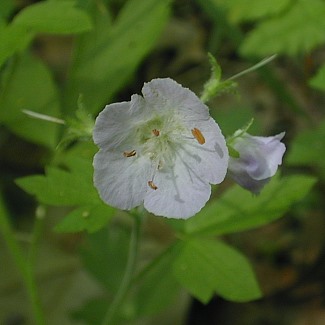Description:
This
biennial plant is 1-2' tall, branching occasionally. The stems
are light green, terete, and covered with spreading hairs; these hairs
are often glandular. The alternate leaves are simple-pinnate; they are
usually divided into 3-5 leaflets (rarely 7). The leaf blades are up to
5" long and 3" across; the petioles of these leaves become shorter as
they ascend the stems. The leaflets of each blade are ovate, broadly
ovate, oblong, or oblanceolate in shape; they are shallowly to deeply
cleft and bluntly dentate along their margins. Often, the terminal
leaflets are more deeply cleft than the lateral leaflets. Both leaf
blades and petioles are more or less hairy. The upper surfaces of
mature blades are medium to dark green; however, the earliest leaf-blades of the
year have upper surfaces with silver-grey blotches. The upper stems
terminate in racemes of 4-12 flowers; often there are a few secondary
racemes that develop from the axils of the upper leaves. Buds and
flowers are typically concentrated toward the apex of each raceme,
while the developing fruits are located below on spreading pedicels.
These pedicels are glandular-hairy and about ½" long. Each flower is
about ½" across when it is in bloom; it consists of a 5-lobed corolla,
a calyx with 5 sepals, 5 stamens, a slender style, and an ovary. The
corolla can vary in color from pale lavender to deep blue-violet. The
green sepals are linear-lanceolate and hairy; they become recurved
during and after the blooming period. The style of each flower divides
into 2 parts toward the middle of its length, while the stamens have
finely hairy filaments and brownish anthers. The blooming period occurs
during the late spring and lasts about a month. Each flower is replaced
by an ovoid seed capsule that divides into 2 parts to release its
seeds. This plant reproduces by reseeding itself.
earliest leaf-blades of the
year have upper surfaces with silver-grey blotches. The upper stems
terminate in racemes of 4-12 flowers; often there are a few secondary
racemes that develop from the axils of the upper leaves. Buds and
flowers are typically concentrated toward the apex of each raceme,
while the developing fruits are located below on spreading pedicels.
These pedicels are glandular-hairy and about ½" long. Each flower is
about ½" across when it is in bloom; it consists of a 5-lobed corolla,
a calyx with 5 sepals, 5 stamens, a slender style, and an ovary. The
corolla can vary in color from pale lavender to deep blue-violet. The
green sepals are linear-lanceolate and hairy; they become recurved
during and after the blooming period. The style of each flower divides
into 2 parts toward the middle of its length, while the stamens have
finely hairy filaments and brownish anthers. The blooming period occurs
during the late spring and lasts about a month. Each flower is replaced
by an ovoid seed capsule that divides into 2 parts to release its
seeds. This plant reproduces by reseeding itself.
Cultivation:
The preference is dappled sunlight to light shade, moist conditions,
and a rather rich loam or silt-loam containing organic matter. After
the flowering period, more shade from canopy trees is tolerated because
this plant dies down. While this plant doesn't grow on rocks like some
ferns, it tolerates soil that is somewhat thin and rocky from
underlying bedrock if there is enough moisture.
Range & Habitat:
The native Forest Phacelia occurs occasionally in the southern half of
Illinois,
while in the northern half of the state it is rare or absent (see Distribution
Map). Habitats include moist areas of deciduous woodlands and
rocky woodlands, rocky banks and low areas along woodland streams,
moist depressions of bluffs, bottoms of sandstone canyons, and lower
slopes of ravines. This wildflower is typically found in various moist
areas of rocky woodlands.
Faunal Associations:
The nectar and pollen of the flowers attract primarily bees
(long-tongued & short-tongued); less common floral visitors
include butterflies, skippers, and wasps. The foliage of Phacelia
spp. (Phacelias) is eaten by the the oligophagous Scelolyperus
wilcoxi (Skeletonizing Leaf Beetle sp.). Information about
the edibility of the foliage to mammalian herbivores is unavailable.

Photographic
Location:
The bottom of a sandstone canyon along a woodland stream at the
Portland Arch in west-central Indiana.
Comments:
Forest Phacelia is another lovely woodland wildflower in the Waterleaf
family. This species and other Phacelia spp.
(Phacelias) are closely related to the Hydrophyllum spp.
(Waterleaf species), which also occur in woodlands and bloom at about
the same time. Among the species in Illinois, the style of a Phacelia
is divided toward the middle of its length, while the style of a
Waterleaf is divided toward its apex; this is the easiest way to
distinguish these two groups of very similar wildflowers. Compared to
other Phacelias in Illinois, Forest Phacelia usually has larger flowers
(about ½" across, if not more) and the lobes of its corollas are
smooth, rather than conspicuously fringed. Some species of Waterleaf
are similar to it, but they lack tripartite leaves or the lobes of
their corollas are less widely spreading when the flowers are blooming.
If all else fails, they can be distinguished by their styles, as
described above. Another common of Phacelia bipinnatifida
is Loose-Flowered Phacelia.